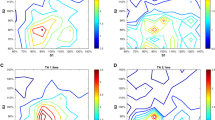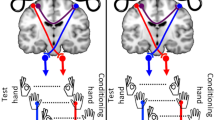Abstract
Short-interval intracortical inhibition (SICI) is a widely used method to study cortical inhibition, and abnormalities have been found in several neurological and psychiatric disorders. Previous studies suggested that SICI involves two phases and the first phase may be explained by axonal refractoriness. Our objectives are to further investigate the mechanisms of the two phases of SICI. SICI was studied in 11 normal volunteers by a paired transcranial magnetic stimulation (TMS) paradigm applied to the left motor cortex with a subthreshold conditioning stimulus (80% resting motor threshold for rest condition and 95% active motor threshold for active condition) followed by a suprathreshold test stimulus at interstimulus intervals (ISIs) of 1–4.5 ms in steps of 0.5 ms. Motor-evoked potentials (MEPs) were recorded from the right first dorsal interosseous muscle. Three different test stimulus intensities adjusted to produce 0.2, 1 and 4 mV MEPs at rest were studied with the target muscle relaxed and during 20% maximum contraction. Maximum inhibition was observed at ISIs of 1 ms and 2.5 ms for the rest condition and the difference among ISIs was reduced with voluntary contraction. SICI increased with larger test MEP amplitude and decreased with voluntary contraction. At test MEP of 0.2 mV, some subjects showed facilitation and this is likely related to short-interval intracortical facilitation. For rest SICI, the correlation between adjacent ISIs was much higher from 3 to 4.5 ms than from 1 to 2.5 ms or between 1 and 2.5 ms. There was no correlation between SICI at different test MEP amplitudes. We conclude that maximum SICI at ISIs of 1 and 2.5 ms are mediated by different mechanisms. SICI at 1 ms cannot be fully explained by axonal refractoriness and synaptic inhibition may be involved. SICI is a complex phenomenon and inhibition at different ISIs may be mediated by different inhibitory circuits.






Similar content being viewed by others
References
Awiszus F, Feistner H, Urbach D, Bostock H (1999) Characterisation of paired-pulse transcranial magnetic stimulation conditions yielding intracortical inhibition or I-wave facilitation using a threshold-hunting paradigm. Exp Brain Res 129:317–324
Chan JH, Lin CS, Pierrot-Deseilligny E, Burke D (2002) Excitability changes in human peripheral nerve axons in a paradigm mimicking paired-pulse transcranial magnetic stimulation. J Physiol 542:951–961
Chen R, Garg R (2000) Facilitatory I wave interaction in proximal arm and lower limb muscle representations of the human motor cortex. J Neurophysiol 83:1426–1434
Chen R, Tam A, Butefisch C, Corwell B, Ziemann U, Rothwell JC, Cohen LG (1998) Intracortical inhibition and facilitation in different representations of the human motor cortex. J Neurophysiol 80:2870–2881
Daskalakis ZJ, Christensen BK, Chen R, Fitzgerald PB, Zipursky RB, Kapur S (2002a) Evidence for impaired cortical inhibition in schizophrenia using transcranial magnetic stimulation. Arch Gen Psychiatry 59:347–354
Daskalakis ZJ, Christensen BK, Fitzgerald PB, Roshan L, Chen R (2002b) The mechanisms of interhemispheric inhibition in the human motor cortex. J Physiol 543:317–326
Deletis V, Isgum V, Amassian VE (2001) Neurophysiological mechanisms underlying motor evoked potentials in anesthetized humans. Part 1. Recovery time of corticospinal tract direct waves elicited by pairs of transcranial electrical stimuli. Clin Neurophysiol 112:438–444
Di Lazzaro V, Oliviero A, Meglio M, Cioni B, Tamburrini G, Tonali P, Rothwell JC (2000) Direct demonstration of the effect of lorazepam on the excitability of the human motor cortex. Clin Neurophysiol 111:794–799
Di Lazzaro V, Oliviero A, Profice P, Saturno E, Pilato F, Insola A, Mazzone P, Tonali P, Rothwell JC (1998a) Comparison of descending volleys evoked by transcranial magnetic and electric stimulation in conscious humans. Electroencephalogr Clin Neurophysiol 109:397–401
Di Lazzaro V, Restuccia D, Oliviero A, Profice P, Ferrara L, Insola A, Mazzone P, Tonali P, Rothwell JC (1998b) Effects of voluntary contraction on descending volleys evoked by transcranial stimulation in conscious humans. J Physiol 508:625–633
Di Lazzaro V, Restuccia D, Oliviero A, Profice P, Ferrara L, Insola A, Mazzone P, Tonali P, Rothwell JC (1998c) Magnetic transcranial stimulation at intensities below active motor threshold activates inhibitory circuits. Exp Brain Res 119:265–268
Fisher RJ, Nakamura Y, Bestmann S, Rothwell JC, Bostock H (2002) Two phases of intracortical inhibition revealed by transcranial magnetic threshold tracking. Exp Brain Res 143:240–248
Hallett M (1995) Transcranial magnetic stimulation. Negative effects. Adv Neurol 67:107–113
Hanajima R, Ugawa Y, Terao Y, Enomoto H, Shiio Y, Mochizuki H, Furubayashi T, Uesugi H, Iwata NK, Kanazawa I (2002) Mechanisms of intracortical I-wave facilitation elicited with paired-pulse magnetic stimulation in humans. J Physiol 538:253–261
Ilic TV, Meintzschel F, Cleff U, Ruge D, Kessler KR, Ziemann U (2002) Short-interval paired-pulse inhibition and facilitation of human motor cortex: the dimension of stimulus intensity. J Physiol 545:153–167
Kaneko K, Kawai S, Fuchigami Y, Morita H, Ofuji A (1996) The effect of current direction induced by transcranial magnetic stimulation on the corticospinal excitability in human brain. Electroencephalogr Clin Neurophysiol 101:478–482
Kujirai T, Caramia M, Rothwell JC, Day B, Thompson P, Ferbert A, Wroe S, Asselman P, Marsden C (1993) Corticocortical inhibition in human motor cortex. J Physiol 471:501–519
Nakamura H, Kitagawa H, Kawaguchi Y, Tsuji H (1997) Intracortical facilitation and inhibition after transcranial magnetic stimulation in conscious humans. J Physiol 498:817–823
Nowak LG, Bullier J (1998) Axons, but not cell bodies, are activated by electrical stimulation in cortical gray matter. I. Evidence from chronaxie measurements. Exp Brain Res 118:477–488
Ridding MC, Inzelberg R, Rothwell JC (1995a) Changes in excitability of motor cortical circuitry in patients with Parkinson's disease. Ann Neurol 37:181–188
Ridding MC, Sheean G, Rothwell JC, Inzelberg R, Kujirai T (1995b) Changes in the balance between motor cortical excitation and inhibition in focal, task specific dystonia. J Neurol Neurosurg Psychiatry 39:493–498
Sailer A, Molnar GF, Cunic DI, Chen R (2002) Effects of peripheral sensory input on cortical inhibition in humans. J Physiol 544:617–629
Sanger TD, Garg RR, Chen R (2001) Interactions between two different inhibitory systems in the human motor cortex. J Physiol 530:307–317
Strafella AP, Paus T (2001) Cerebral blood-flow changes induced by paired-pulse transcranial magnetic stimulation of the primary motor cortex. J Neurophysiol 85:2624–2629
Tokimura H, Ridding MC, Tokimura Y, Amassian VE, Rothwell JC (1996) Short latency facilitation between pairs of threshold magnetic stimuli applied to human motor cortex. Electroencephalogr Clin Neurophysiol 101:263–272
Wassermann EM (2002) Variation in the response to transcranial magnetic brain stimulation in the general population. Clin Neurophysiol 113:1165–1171
Werhahn KJ, Fong JK, Meyer BU, Priori A, Rothwell JC, Day BL, Thompson PD (1994) The effect of magnetic coil orientation on the latency of surface EMG and single motor unit responses in the first dorsal interosseous muscle. Electroencephalogr Clin Neurophysiol 93:138–146
Ziemann U, Lonnecker S, Steinhoff BJ, Paulus W (1996a) Effects of antiepileptic drugs on motor cortex excitability in humans: a transcranial magnetic stimulation study. Ann Neurol 40:367–378
Ziemann U, Lonnecker S, Steinhoff BJ, Paulus W (1996b) The effect of lorazepam on the motor cortical excitability in man. Exp Brain Res 109:127–135
Ziemann U, Paulus W, Rothenberger A (1997) Decreased motor inhibition in Tourette's disorder: evidence from transcranial magnetic stimulation. Am J Psychiatry 154:1277–1284
Ziemann U, Rothwell JC (2000) I-waves in motor cortex. J Clin Neurophysiol 17:397–405
Ziemann U, Rothwell JC, Ridding M (1996c) Interaction between intracortical inhibition and facilitation in human motor cortex. J Physiol 496:873–881
Ziemann U, Tergau F, Wassermann EM, Wischer S, Hildebrandt J, Paulus W (1998) Demonstration of facilitatory I wave interaction in the human motor cortex by paired transcranial magnetic stimulation. J Physiol 511:181–190
Acknowledgements
We thank Carolyn Gunraj for technical assistance and Dr. Jeff Daskalakis for his valuable comments on the manuscript. The study was supported by the Canadian Institutes of Health Research (CHIR), Canada Foundation for Innovation, Ontario Innovation Trust and the University Health Network Krembil Family Chair in Neurology. RC is a Canadian Institutes of Health Research New Investigator.
Author information
Authors and Affiliations
Corresponding author
Rights and permissions
About this article
Cite this article
Roshan, L., Paradiso, G.O. & Chen, R. Two phases of short-interval intracortical inhibition. Exp Brain Res 151, 330–337 (2003). https://doi.org/10.1007/s00221-003-1502-9
Received:
Accepted:
Published:
Issue Date:
DOI: https://doi.org/10.1007/s00221-003-1502-9




